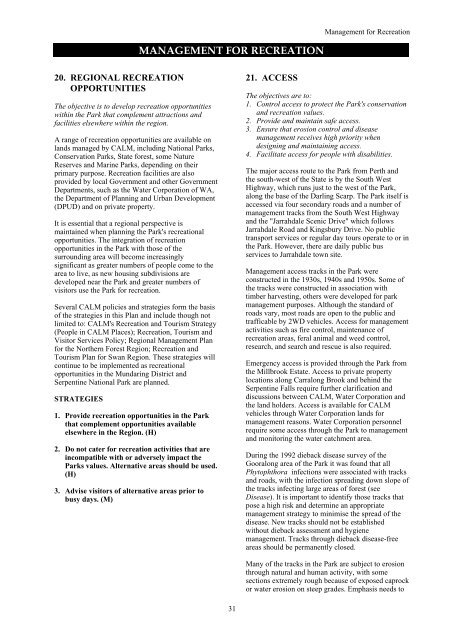Serpentine National Park - Department of Environment and ...
Serpentine National Park - Department of Environment and ...
Serpentine National Park - Department of Environment and ...
You also want an ePaper? Increase the reach of your titles
YUMPU automatically turns print PDFs into web optimized ePapers that Google loves.
20. REGIONAL RECREATION<br />
OPPORTUNITIES<br />
The objective is to develop recreation opportunities<br />
within the <strong>Park</strong> that complement attractions <strong>and</strong><br />
facilities elsewhere within the region.<br />
A range <strong>of</strong> recreation opportunities are available on<br />
l<strong>and</strong>s managed by CALM, including <strong>National</strong> <strong>Park</strong>s,<br />
Conservation <strong>Park</strong>s, State forest, some Nature<br />
Reserves <strong>and</strong> Marine <strong>Park</strong>s, depending on their<br />
primary purpose. Recreation facilities are also<br />
provided by local Government <strong>and</strong> other Government<br />
<strong>Department</strong>s, such as the Water Corporation <strong>of</strong> WA,<br />
the <strong>Department</strong> <strong>of</strong> Planning <strong>and</strong> Urban Development<br />
(DPUD) <strong>and</strong> on private property.<br />
It is essential that a regional perspective is<br />
maintained when planning the <strong>Park</strong>'s recreational<br />
opportunities. The integration <strong>of</strong> recreation<br />
opportunities in the <strong>Park</strong> with those <strong>of</strong> the<br />
surrounding area will become increasingly<br />
significant as greater numbers <strong>of</strong> people come to the<br />
area to live, as new housing subdivisions are<br />
developed near the <strong>Park</strong> <strong>and</strong> greater numbers <strong>of</strong><br />
visitors use the <strong>Park</strong> for recreation.<br />
Several CALM policies <strong>and</strong> strategies form the basis<br />
<strong>of</strong> the strategies in this Plan <strong>and</strong> include though not<br />
limited to: CALM's Recreation <strong>and</strong> Tourism Strategy<br />
(People in CALM Places); Recreation, Tourism <strong>and</strong><br />
Visitor Services Policy; Regional Management Plan<br />
for the Northern Forest Region; Recreation <strong>and</strong><br />
Tourism Plan for Swan Region. These strategies will<br />
continue to be implemented as recreational<br />
opportunities in the Mundaring District <strong>and</strong><br />
<strong>Serpentine</strong> <strong>National</strong> <strong>Park</strong> are planned.<br />
STRATEGIES<br />
1. Provide recreation opportunities in the <strong>Park</strong><br />
that complement opportunities available<br />
elsewhere in the Region. (H)<br />
2. Do not cater for recreation activities that are<br />
incompatible with or adversely impact the<br />
<strong>Park</strong>s values. Alternative areas should be used.<br />
(H)<br />
3. Advise visitors <strong>of</strong> alternative areas prior to<br />
busy days. (M)<br />
MANAGEMENT FOR RECREATION<br />
31<br />
21. ACCESS<br />
Management for Recreation<br />
The objectives are to:<br />
1. Control access to protect the <strong>Park</strong>'s conservation<br />
<strong>and</strong> recreation values.<br />
2. Provide <strong>and</strong> maintain safe access.<br />
3. Ensure that erosion control <strong>and</strong> disease<br />
management receives high priority when<br />
designing <strong>and</strong> maintaining access.<br />
4. Facilitate access for people with disabilities.<br />
The major access route to the <strong>Park</strong> from Perth <strong>and</strong><br />
the south-west <strong>of</strong> the State is by the South West<br />
Highway, which runs just to the west <strong>of</strong> the <strong>Park</strong>,<br />
along the base <strong>of</strong> the Darling Scarp. The <strong>Park</strong> itself is<br />
accessed via four secondary roads <strong>and</strong> a number <strong>of</strong><br />
management tracks from the South West Highway<br />
<strong>and</strong> the "Jarrahdale Scenic Drive" which follows<br />
Jarrahdale Road <strong>and</strong> Kingsbury Drive. No public<br />
transport services or regular day tours operate to or in<br />
the <strong>Park</strong>. However, there are daily public bus<br />
services to Jarrahdale town site.<br />
Management access tracks in the <strong>Park</strong> were<br />
constructed in the 1930s, 1940s <strong>and</strong> 1950s. Some <strong>of</strong><br />
the tracks were constructed in association with<br />
timber harvesting, others were developed for park<br />
management purposes. Although the st<strong>and</strong>ard <strong>of</strong><br />
roads vary, most roads are open to the public <strong>and</strong><br />
trafficable by 2WD vehicles. Access for management<br />
activities such as fire control, maintenance <strong>of</strong><br />
recreation areas, feral animal <strong>and</strong> weed control,<br />
research, <strong>and</strong> search <strong>and</strong> rescue is also required.<br />
Emergency access is provided through the <strong>Park</strong> from<br />
the Millbrook Estate. Access to private property<br />
locations along Carralong Brook <strong>and</strong> behind the<br />
<strong>Serpentine</strong> Falls require further clarification <strong>and</strong><br />
discussions between CALM, Water Corporation <strong>and</strong><br />
the l<strong>and</strong> holders. Access is available for CALM<br />
vehicles through Water Corporation l<strong>and</strong>s for<br />
management reasons. Water Corporation personnel<br />
require some access through the <strong>Park</strong> to management<br />
<strong>and</strong> monitoring the water catchment area.<br />
During the 1992 dieback disease survey <strong>of</strong> the<br />
Gooralong area <strong>of</strong> the <strong>Park</strong> it was found that all<br />
Phytophthora infections were associated with tracks<br />
<strong>and</strong> roads, with the infection spreading down slope <strong>of</strong><br />
the tracks infecting large areas <strong>of</strong> forest (see<br />
Disease). It is important to identify those tracks that<br />
pose a high risk <strong>and</strong> determine an appropriate<br />
management strategy to minimise the spread <strong>of</strong> the<br />
disease. New tracks should not be established<br />
without dieback assessment <strong>and</strong> hygiene<br />
management. Tracks through dieback disease-free<br />
areas should be permanently closed.<br />
Many <strong>of</strong> the tracks in the <strong>Park</strong> are subject to erosion<br />
through natural <strong>and</strong> human activity, with some<br />
sections extremely rough because <strong>of</strong> exposed caprock<br />
or water erosion on steep grades. Emphasis needs to

















